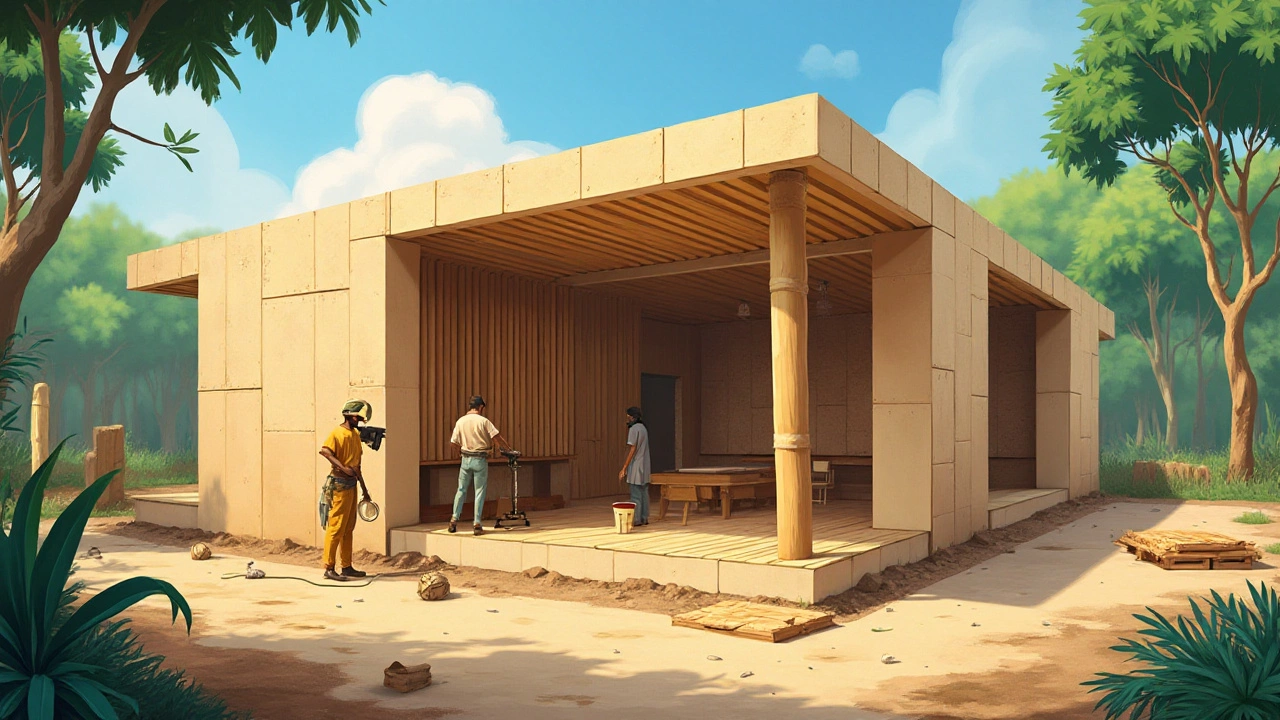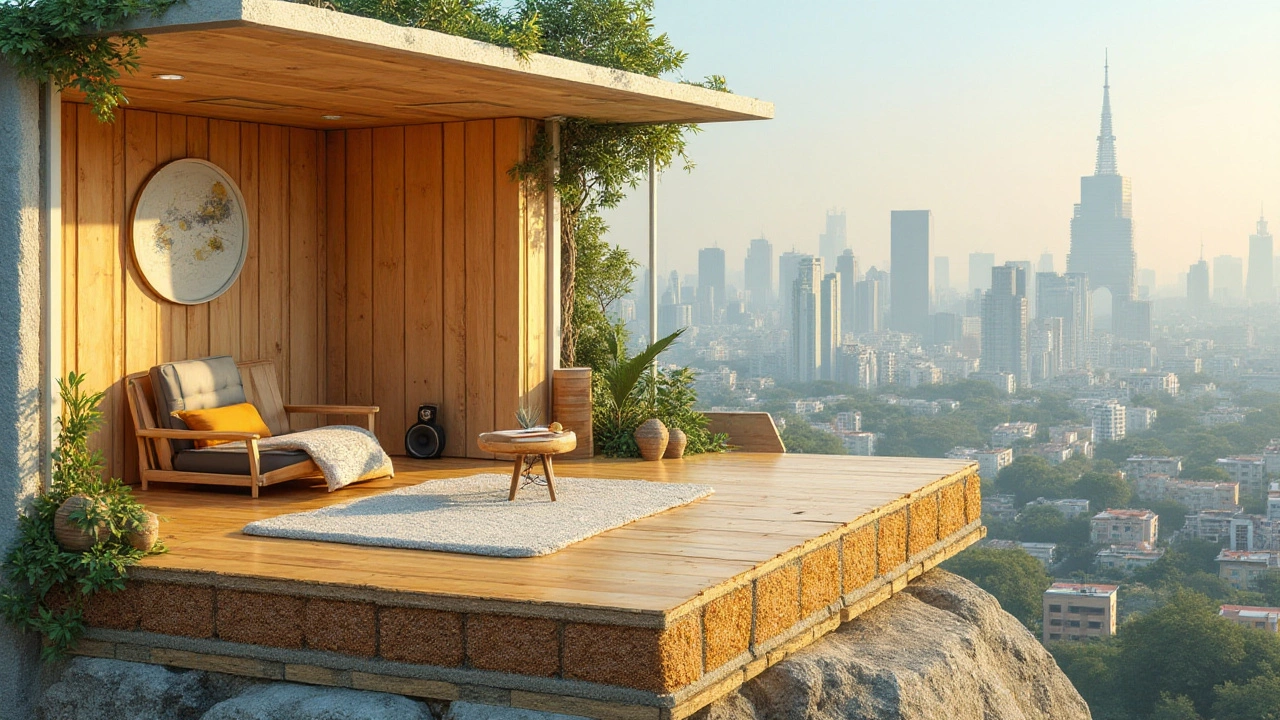Essential Materials for Building a Music Studio in India
 Feb, 4 2025
Feb, 4 2025
Building a music studio is an ambitious yet rewarding endeavor, especially when attention to detail paves the way for superior sound experiences. Materials form the backbone of studio setup, shaping everything from acoustics to aesthetics. In India, creating a harmonious studio space presents its own set of challenges and opportunities, influenced by climate, cost, and resource availability. Whether you're a budding musician or an established producer, understanding how materials impact your studio's sound quality is key to bringing your sonic dreams to life. Let's dive into the world of music studio construction, focusing on what works best within the Indian context.
- Soundproofing Essentials
- Acoustic Treatment Materials
- Flooring and Walls
- Climate and Cost Considerations
Soundproofing Essentials
Soundproofing is a vital aspect of building a music studio. It ensures that the music you create doesn’t escape into the surrounding environment and that external noises don’t infiltrate your sound sanctuary. In India, where bustling cities can present unique noise challenges, selecting the right soundproofing materials is key.
Understanding Sound Transmission
Firstly, grasping the concept of sound transmission is crucial. Sounds can travel through air and solid structures, and addressing both pathways is essential for effective soundproofing. Materials need to absorb, block, and dampen noise at varied frequencies.
Key Materials for Soundproofing
Mass Loaded Vinyl (MLV)
Mass Loaded Vinyl is a popular choice for blocking airborne noise due to its density. It’s flexible, easy to install, and highly effective in barrier construction within walls and ceilings. Soundproofing performance can reach beyond 20dB, significantly reducing noise pollution.
Acoustic Panels
These panels are designed to absorb sound waves, reducing echo and reverb inside the studio. Materials like fiberglass or foam are commonly used. In India, sourcing eco-friendly panels made from recycled materials is becoming increasingly popular, combining efficiency with sustainability.
Door and Window Seals
Even the best walls won’t block sound if gaps around doors and windows are left untreated. High-density rubber door seals and double-glazed windows are essential investments to ensure complete enclosure.
Implementing Soundproofing Techniques
- Decoupling: Separating walls, floors, and ceilings into layers reduces vibrations passing through. This is often done using resilient channels or staggered stud construction.
- Damping: Using products like Green Glue between rigid materials converts sound energy into small amounts of heat, which diminishes sound.
- Absorption: Applying acoustic panels in strategic spots within the studio captures stray sound waves, improving both soundproofing and acoustic clarity.
Soundproofing Cost and Products
The price range for soundproofing can vary significantly. A small, modest studio might require an investment of around ₹50,000 to ₹1,50,000 depending on materials and labor costs. Popular brands offer reliable products, such as Auralex for acoustic foam and Owens Corning for fiberglass alternatives.
| Material | Estimated Cost (Per Sq Meter) | Effectiveness |
|---|---|---|
| Mass Loaded Vinyl | ₹1,000 | High |
| Acoustic Foam Panels | ₹600 | Medium |
| Fiberglass Panels | ₹750 | High |
By understanding and implementing these essential soundproofing strategies, studio enthusiasts in India can cultivate an environment that is both sonically and creatively inspiring. With the right materials and techniques, your music studio will become an oasis of sound purity.
Acoustic Treatment Materials
Acoustic treatment is a fundamental aspect of any music studio, as it dramatically influences sound quality within the space. In India, where ambient noise can range from bustling city streets to industrial zones, selecting the right acoustic treatment materials ensures that recordings and playback maintain pristine clarity. The focus here is to manage sound reflections, reverberations, and echoes within the studio environment.
Understanding Sound Absorption
Sound doesn't always behave the way we want it to, often bouncing around rooms and creating unwanted echoes. The first line of defense is sound absorption. Acoustic panels, often made from materials like foam and fiberglass, are key players here. Foam panels, available in various densities and thicknesses, can help absorb mid to high frequencies efficiently. Meanwhile, fiberglass panels offer a broader range of absorption and are preferred for handling low frequencies as well.
Diffusion for Balanced Sound
While absorption is crucial, too much of it can deaden a room, sucking out life from music tracks. This is where diffusion comes in, scattering sound waves in different directions to create a sense of space while maintaining musical vibrancy. Diffusers are often constructed from wood and come in a variety of shapes, from quadratic residue diffusers to skyline patterns.
According to John Storyk, a respected acoustician, "The art of acoustic treatment is not in eliminating sound but in managing it."
Selecting Materials with a Local Perspective
Construction materials should be selected not only for their acoustic properties but also for their availability and adaptability to Indian climates. Locally sourced jute and recycled cotton panels are emerging as sustainable alternatives. These materials are not only efficient in sound absorption but also environmentally friendly, tapping into India’s growing emphasis on sustainable practices.
For those on a budget, India offers a plethora of traditional textile options that can double as decor and sound absorbers. Heavy curtains or densely woven rugs can help dampen unwanted noise, creating a cozy, aesthetically pleasing environment.
Cost-effective Options
- Cork Panels: Renewable and cost-effective, cork is excellent for soundproofing and adding a natural vibe to your studio.
- Egg Cartons: Though less effective than commercial acoustic panels, egg cartons are a popular DIY choice for their diffusion capabilities and cost-effectiveness.
By understanding and strategically implementing these acoustic treatment materials, one can conquer the dual challenges of noise and reverberation, paving the way for a professional-quality studio environment. Exploring both traditional and modern options can lead to a workspace that resonates with India's unique acoustic landscape.

Flooring and Walls
The choice of flooring and walls is pivotal when setting up a music studio in India. Not only do these elements contribute to the aesthetics, but they play a significant role in soundproofing and acoustic quality. It's essential to select materials that minimize noise leakage and enhance the overall audio environment of your studio space.
Choosing the Right Flooring
Flooring in a music studio should effectively dampen sound while being durable enough to withstand heavy use. Carpet tiles are a popular choice due to their sound absorption properties, which help in reducing ambient noise and echoes. However, for those seeking a more sophisticated look, cork flooring is an excellent alternative. Cork provides not only a warm aesthetic but also serves as a natural insulator against sound.
In terms of cost and availability, laminate flooring with a cushioned underlay is another viable option, especially considering the Indian climate's challenges. It offers a balance between cost-efficiency and quality sound reduction capabilities.
Constructing Acoustically Sound Walls
Acoustic treatment for walls involves using specific materials to control sound reflections within the studio. One effective approach involves the use of gypsum board, which is widely available and provides decent soundproofing. For enhanced results, consider installing sound insulation panels, which are particularly useful for controlling low frequencies.
Mineral wool or glass wool panels are also commonly used within the cavity of wall constructions, significantly reducing sound transmission between rooms. They are particularly effective in Indian studios, where managing the reverberation is crucial due to climatic reflections.
Insulation and Aesthetic Considerations
The aesthetic elements of wall design shouldn’t compromise acoustical function. Fabric-covered acoustic panels or diffusers can add a creative touch while retaining their functional role. Designing with a mix of hard and soft wall surfaces helps to balance the acoustics, reducing echo while maintaining a lively sound atmosphere.
To demonstrate the variety of material options and their relative costs, here's a quick look at some common choices:
| Material | Cost per Sq Ft (INR) | Soundproofing Rating |
|---|---|---|
| Carpet Tiles | 50-100 | Moderate |
| Cork Flooring | 150-250 | High |
| Gypsum Board | 40-80 | Moderate |
| Sound Panels | 300-500 | Very High |
Selecting the right flooring and walls is crucial for optimizing your studio's acoustics without breaking the bank. Balancing cost, availability, and acoustic performance tailored to the unique Indian circumstances can ensure your music studio resonates just the way you intend.
Climate and Cost Considerations
In India, the diversity of climate regions presents unique challenges and opportunities when selecting materials for a music studio setup. From the humid coastal areas to the dry, arid interiors, understanding the environment in which you're building can significantly impact your studio's longevity and effectiveness.
Climate Impacts on Material Choice
High humidity levels, prevalent in coastal cities like Chennai and Mumbai, can wreak havoc on wooden installations, causing warping and mold growth. Here, moisture-resistant panels, such as treated plywood or engineered wood, stand up better to the elements. Additionally, using anti-fungal treatments and dehumidifiers can protect your investment, ensuring the studio's life is not prematurely cut short by environmental factors.
Managing Extreme Temperatures
In contrast, arid regions, such as Rajasthan, deal with extreme temperature fluctuations. Insulating materials like fiberglass or foam not only aid in soundproofing but also help maintain a stable internal environment. The right insulation minimizes reliance on air conditioning and heating, reducing ongoing costs while protecting sensitive electronic equipment from overheating.
Cost-effective Solutions
Budget constraints often dictate the choice of materials, but clever sourcing and recycling can make a difference. Locally sourced materials are not only cost-effective, but also minimize environmental impact. Bamboo, for instance, is not only a sustainable option but also offers excellent acoustic properties.
Estimating the Budget
Understanding the cost considerations is crucial for planning. Here's a rough breakdown of potential expenses:
| Material | Approximate Cost (INR) |
|---|---|
| Soundproofing Insulation | 200 to 400 per sq. ft |
| Acoustic Panels | 500 to 1500 per piece |
| Flooring | 100 to 300 per sq. ft |
| Climate Control Systems | 10,000 to 50,000 |
These estimates can vary based on quality, brand, and region. Bargaining and bulk buying can further reduce costs, making the dream of a professional-grade studio more accessible.
The creative decision-making involved in setting up a music studio in India isn't just about materials; it's a thoughtful balance of environment, cost, and resourcefulness. With informed choices, the potential for crafting an acoustically refined space that meets both budget and environmental conditions is well within reach for any aspiring music enthusiast.